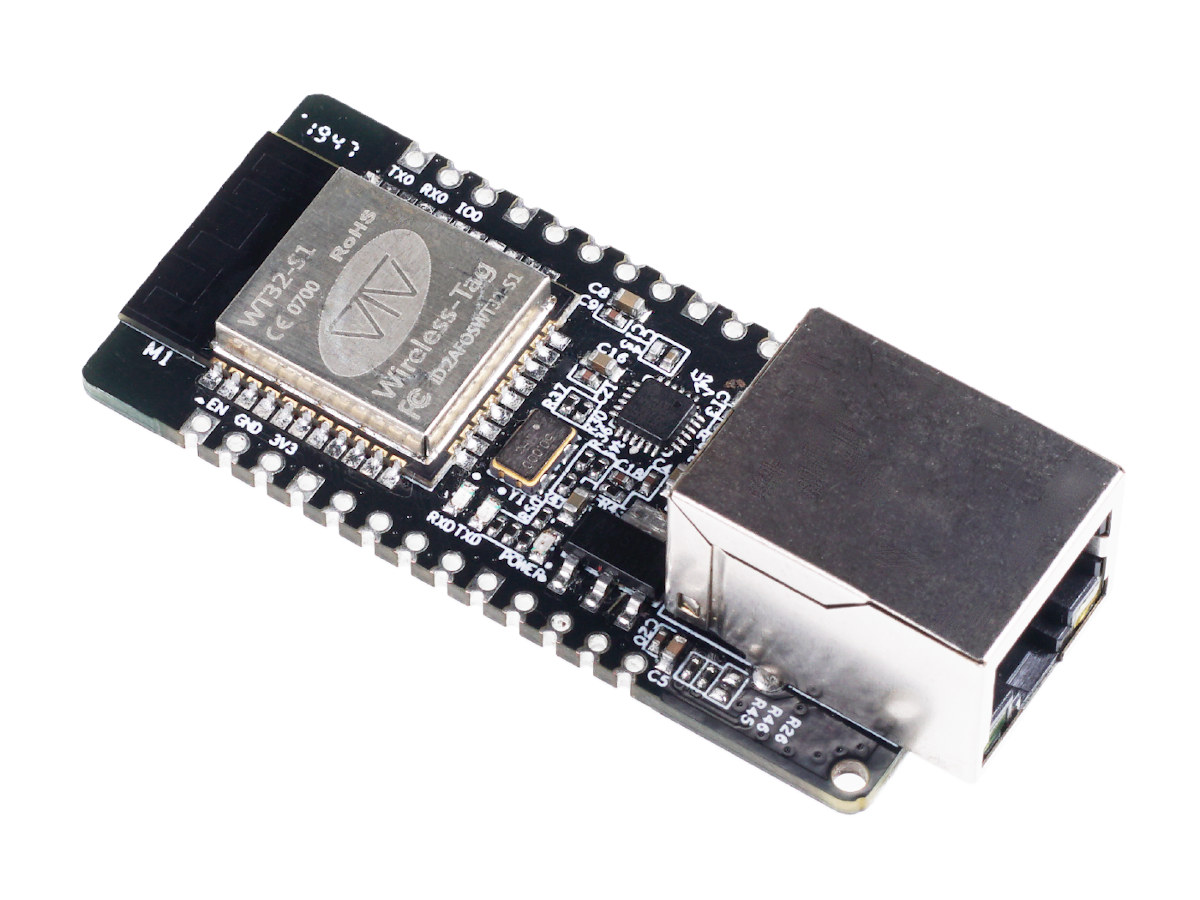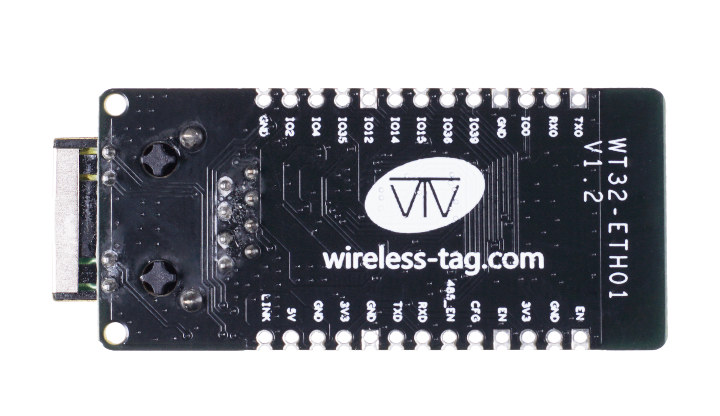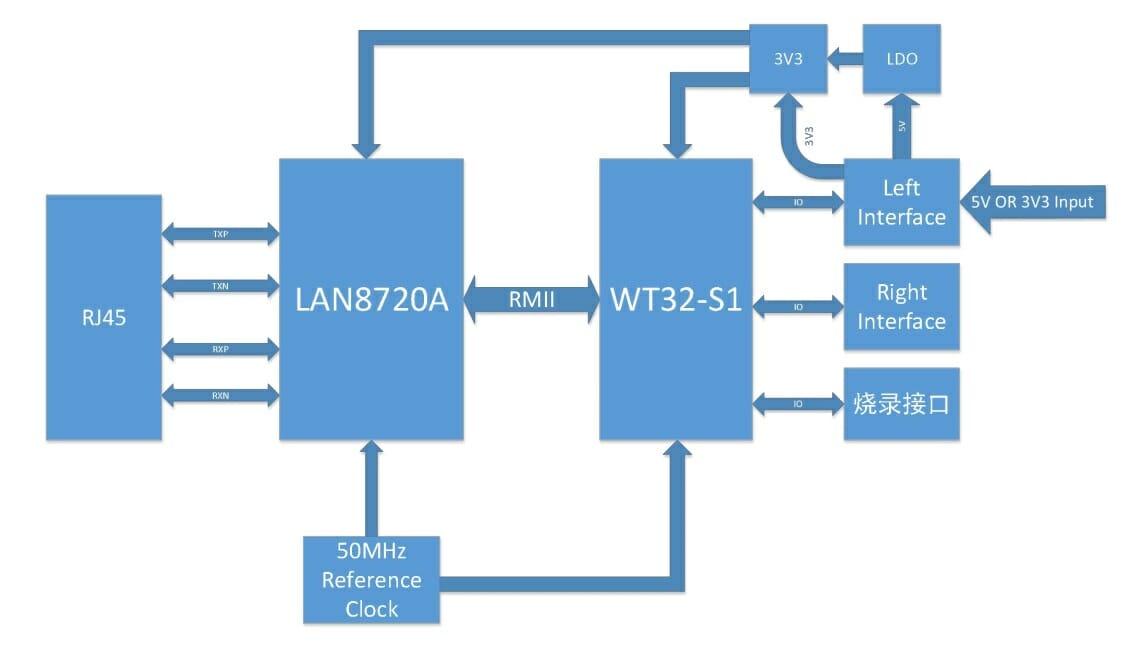Espressif Systems ESP32 processor supports WiFi, Bluetooth, and Ethernet connectivity. There are only a few boards coming with an Ethernet RJ45 jack out of the box including esp32MX-E ESP32 board, TTGO T-Internet-POE, and Olimex ESP32-Gateway board among others.
Those boards are fine, but they sell for $16 and up, so if you’d like a cheaper and tinier ESP32 board with Ethernet, Wireless Tag WT32-ETH01 may be an option for projects not requiring PoE support.

- Wireless Module – Wireless Tag WT32-S1 based on ESP32 dual-core WiSoC with 4MB flash, on-board antenna
- Connectivity
- 10/100M Ethernet via LAN8720A transceiver
- 2.4 GHz 802.11b/g/n WiFi 4 up to 150 Mbps
- Bluetooth 4.2 BR/EDR and LE
- Expansion – 2x 13 through holes and castellated holes with GPIOs, I2C, SPI, 2x UART, EN, LINK, 5V, 3.3V, and GND signals
- Power Supply – 3.3V or 5.5V via headers, minimum 500 mA; typical operating current: 80 mA
- Dimensions – 6 x 2.5 cm
- Temperature Range – -40°C to +85°C
- Certifications – FCC/CE/RoHS

It looks to be shipping with firmware that’s controlled via AT commands, but as an ESP32 board, you may be able to run other firmware like Arduino or MicroPython with some work. If you’d like to integrate WT32-ETH01 ESP32 Ethernet board into a home automation project, you’ll be glad to know the board has very recently been added to Tasmota firmware.


Jean-Luc started CNX Software in 2010 as a part-time endeavor, before quitting his job as a software engineering manager, and starting to write daily news, and reviews full time later in 2011.
Support CNX Software! Donate via cryptocurrencies, become a Patron on Patreon, or purchase goods on Amazon or Aliexpress





This is a really nice board for general home automation tasks that you would normally use a plain wireless module for. I can see it being used in e.g. linking alarm systems to the internet (IP serial gateway), bluetooth or WiFi presence detection (mounted on a board with a HLK AC-DC module) reporting via Ethernet, HVAC integration/automation, etc.
A lot of use cases could benefit from Ethernet, while not requiring external power.
I don’t know why they didn’t at least add the possibility to use passive PoE. Power injectors for passive PoE are readily available, and cheap. This would’ve made this module the first choice for Ethernet based sensor nodes.
Indeed. Breaking out the 4 unused ethernet pins to a header that could be bridged to the ground and power traces on the PCB (possibly via a switching DCDC converter) would be a simple matter. Or possibly even a bridgeable solder pad. in the case that the passive power would be 5 v or 3v3.
The problem is the ethernet jack itself. RJ45 connectors with integrated magnetics providing the connectors for the unused pins are rare and more expensive. I wouldn’t be surprised if the limited choice added one dollar to the total BoM, really! At one point one must choose between cost and extensivity :-/
I like the idea of this board, but does anyone else see a problem with trying to mount a castelated board like that when it’s got through hole components sticking out the bottom? You’re going to have a lot of router work on the PCB you mount this to to provide clearance for all of those wires and the ethernet jack mounting studs.
Nobody’s forcing you to buy it. If it doesn’t meet your needs, just move along.
Did someone force you to leave that comment?
Indeed! It’s possible they didn’t find an SMD-only ethernet jack. I spent some time searching one for the breadbee, and these connectors (featuring integrated magnetics) are not common at all, and quite expensive.
Oh, I understand how hard it is to find SMD ethernet jacks. There’s plenty of mechanical reasons why such a thing is a bad idea, so there’s not going to be a lot of demand.
What they could have done was to move the jack a little away from the castelated area so that the routing of the host board would be simpler. But how it’s arranged, they made the job a lot harder.
Yes I definitely agree, the jack could have remained out of the board. Even making a riser board using a rectangular PCB is not easy right now. A few more millimiters would have solved this.
David,
The Seeed page has a little more information:-
“…the module is compatible with half-pad and through-hole connectors. The board width is a universal width and therefore, it can be directly soldered to boards, connectors, or even breadboards…”
So it looks as though those aren’t the dreaded, early ESP03 style castellated connectors, thank goodness!
Indeed it looks possible to use a regular 2.54mm pin array which would then also serve as a riser. But the point still stands that the castellated pads are not practically usable without grinding holes in the board.
Might as well have put normal holes on the board and put 0.1″ headers on it like so many other boards. That’s also a tried-and-true mounting method. 🙂
It looks like they should have added 1mm to be board length to get a bit more space between the pins and the connector. Even a few more mm so that the whole connector ends up off the edge of the board on the cheap green 2.54mm proto boards when soldered down.
The only real bad thing imho of this device there are zero useable docs for.
This is very nice ! I presume that the code has to be modified to work on ethernet instead of wifi. Someone has already convert a code with ethernet ? Is it simple ? Possible to use ethernet and wifi in fallback ?
Check out Tasmota code (See link to discussion I’ve linked to in the article).
is that WT32-ETH01 module able to flash any firmware you want with the normal tools of ESP-IDF or does the hardware/firmware/efuses/flash not allow to do so?
is the ethernet possible to work on PPPOE to connect to internet and its wifi as an AP?